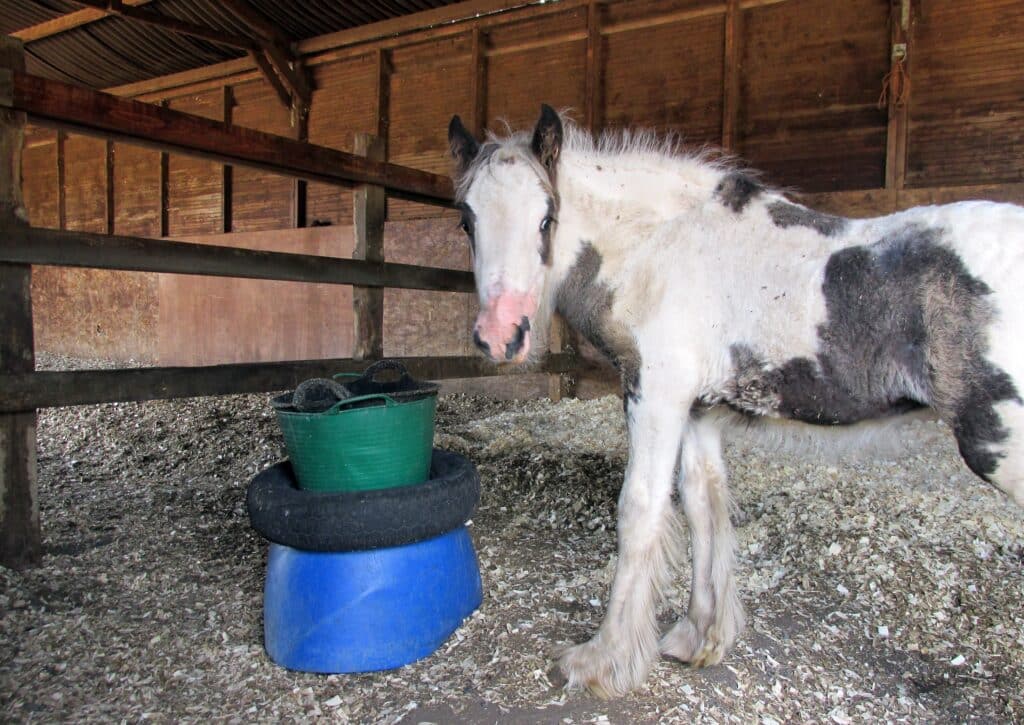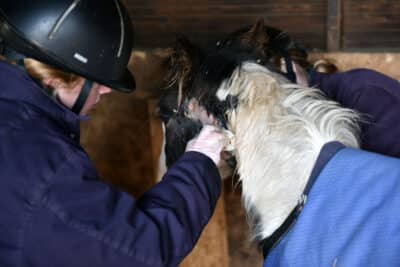Diseases & Conditions, Strangles
Treating a strangles patient
Helen Whitelegg, Senior Campaigns Officer at Redwings, discusses the details
Quarantine care
Well-planned quarantine systems mean we can offer strangles patients all the care they need, while still containing the spread of infectious disease.
Taking the time to set up a well-planned quarantine area makes it more effective and easier to use. Think about where feed, bedding, stable equipment and nursing supplies will be stored; how rubbish and muck will be managed and disposed of; how people can move safely in and out of quarantine, and, how to ensure everyone on the yard understands their own role in keeping quarantine effective.
Although strangles is not airborne, infectious material can still travel some distance when coughed or snorted out by an infected horse, so be generous when setting your quarantine area boundary.
Strangles TLC
Although the majority of horses recover completely from strangles, the disease is sadly fatal in around 2-8% of cases. Even horses that survive can go through a period of very unpleasant, debilitating illness that can be hard to witness. Although there is no treatment that ‘cures’ an active strangles infection, both vets and owners have important roles to play in supporting patients as the disease takes its course:
- Non-steroidal anti-inflammatory painkillers can reduce fever and improve appetite by alleviating a sore throat.
- A quiet, deeply-bedded stable or shelter will encourage the horse to rest.
- Good ventilation is essential – remember strangles is not airborne, so airflow does not increase the risk of transmission.
- Encourage the patient to eat and stay hydrated.
- Soaking feed and/or hay can make it easier to swallow and increase fluid intake.
- Raised feed bowls often help a horse who is struggling to eat as strangles can make lowering the head uncomfortable.
- Try adding appetisers such as sugar beet, grated carrots or handfuls of fresh grass to hard feed if the patient is not eating well.
- Don’t add medication to feed if it remains uneaten; find other ways of administering it to the horse to ensure they get the drugs and their feed.
- Infected horses need to be monitored closely as symptoms can develop rapidly. If in doubt, always contact your vet.
Support the horse’s mental wellbeing as isolation often compromises a horse’s need for companionship. If possible, ensure the stable offers a wide field of vision, preferably with other horses in sight. A stable mirror can also help give a sense of companionship during time in isolation. Enrichment activities such as feed balls or multiple feeding points may relieve boredom, particularly once the horse’s demeanour improves.

Antibiotics and strangles
Most bacterial infections are targeted with antibiotics, but there is growing uncertainty over how effective these drugs are in strangles cases. More research is needed to help us understand how they impact on the progression of the disease and horses’ immunity levels after recovering from infection. At Redwings, we do not routinely prescribe antibiotics for horses with strangles. However, our vets always consider the best course of action on a case-by-case basis and, antibiotics can be an important option for infected horses who develop complications or, are struggling to cope with the effects of the disease. The Redwings strangles and antibiotics blog has more information and a link to research on the topic. The current best practice guidance in the prevention and management of strangles states that ‘The use of systemic antimicrobials should be avoided unless they are indicated in horses with dysphagia, dyspnoea or persistent pyrexia.’
Abscess care
Although abscesses are one of the most recognisable signs of strangles, not all infected horses will present with these pus-filled swellings. Horses that do develop abscesses that subsequently burst through the skin benefit from good nursing care. Many will be increasingly dull as abscesses increase in size, then show a marked improvement in demeanour as the abscess ruptures and pressure is released. If the horse remains depressed once an abscess bursts, it may be that other abscesses are present. These may not be visible and can burst internally into the guttural pouches.
Warm compresses can be applied carefully to encourage an abscess to rupture. Many horses seem to find compresses soothing, but avoid using them on a horse who finds the process painful or stressful. Use a bowl of warm water (think bath temperature) to soak cotton wool or a clean rag. Squeeze excess water out then hold gently against the abscess until the material cools. Repeat several times then ensure everything used is disinfected and/or disposed of carefully.
Once an abscess has burst, the same technique can be used to encourage drainage and clean dried pus that can ‘burn’ the skin. Long hair can be trimmed carefully with scissors to help heat reach the skin and keep the area clean. Wipe carefully outwards away from the point of rupture to avoid introducing dirt or debris into the hole. These steps also help reduce the amount of bacteria contaminating the quarantine area, further reducing the risk of infection being inadvertently carried out of the area and potentially spreading the disease. Remember that abscess pus is highly infectious and everything used to clean the area must be thoroughly disinfected before being put away or disposed of, including the water.

Recovering patients
Infected horses are likely to remain infectious for some time after they appear to have recovered from the illness. It is essential that horses are tested and confirmed to be negative before they are released from quarantine. Both the horses and their environment can continue to be sources of infection even if no pus is being produced.
Use enrichment to help horses cope with their time in quarantine. For ideas go to https://www.redwings.org.uk/news-and-views/enrichment
Remember that horses can be quarantined in a secure paddock if it is carefully planned and set-up. Using live electric tape to create a gap between the horse and the boundary fence is helpful, and all the same precautions must be taken as for a horse in a stable. A stable or field shelter is easier for managing a horse with active signs of infection, but paddock quarantine can be beneficial for their mental wellbeing before they have been given the all-clear.
Field quarantine is especially useful when a group of horses develops the disease. During Redwings outbreak we quarantined a herd of infected horses in their paddock, only moving individuals to a more contained area when their symptoms meant they required additional comfort and TLC.
Last but not least …
The final step for any infected horse should always be guttural pouch endoscopy to check pouch health and take a sample for testing. This process will help identify any horse at risk of becoming a strangles carrier and enable them to be treated and cleared of infection before being reintroduced to other horses.
